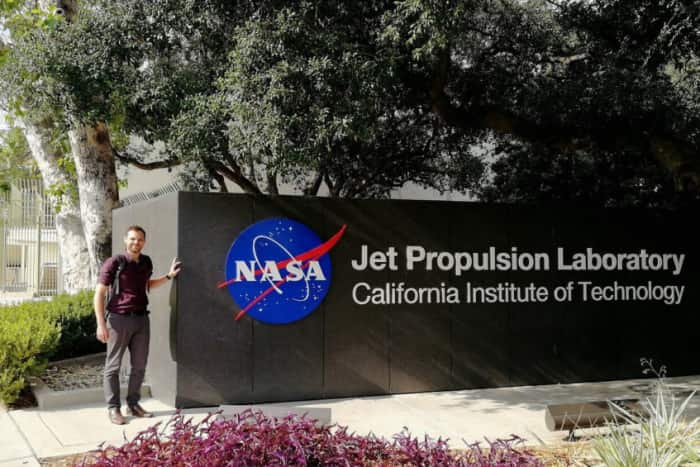3D printing affords infinite opportunity to engineers, designers, makers, and creators of all types—with innovative tendrils that continue to stretch around the world, always growing. This is in daily evidence as new techniques in 3D printing are uncovered and displayed on a continual basis, allowing others to explore new methods with hardware, software, materials, and more.
Recently, one of Sheffield’s Advanced Manufacturing Research Centre’s engineers demonstrated new technology to scientists from NASA. An AMRC development engineer and additive manufacturing specialist, Mark Cocking was asked to show off his new findings and methods regarding THREAD technology at a NASA-JPL workshop spanning two days. THREAD (international patents pending) manufactures parts in a more streamlined process, offering non-stop connectivity and improved performance through all axes. With THREAD 3D printed parts using SLA, DLP and SLS can be threaded through by copper or fibers. This lets you create polymer parts with interesting material characteristics. Together with a regular 3D printer you could use THREAD to make conductive parts or circuits.
The NASA lab that housed the workshop is famed for complex projects regarding our solar system, the universe, and a variety of robotic missions on Earth. There, Cocking discussed ‘embedded technologies in additive manufacturing’ and also unveiled features made via THREAD that could function in something like a space rover. Michael Schein of NASA-JPL referred to Cocking’s technology as ‘extremely impressive,’ and the workshop was deemed a success; in fact, THREAD was the only method from outside the US to be discussed at the workshop.
Mr Cocking showcased THREAD technology and led a focused discussion group on embedded functionalities in AM for his peers from across NASA and those attending the workshop. He also demonstrated a use-case for a component designed using the THREAD process which could be used on a NASA space-rover style vehicle; showcasing how the process could be used to design components, optimised not only for load, but for the inclusion of embedded functionality.
“The fact that THREAD was invited to be featured at the workshop at NASA – one of the world’s best known aerospace research organisations – just shows the global reach of research that takes place at the AMRC,” stated Cocking. “NASA has potential use-cases for upcoming projects for which they could utilise THREAD for embedding functionality into AM components.”
 The AMRC engineer also explained that THREAD technology can be used in a variety of different very important applications, to include energy, medical, and aerospace—with strong potential for ‘spaceflight assembly’ design.
The AMRC engineer also explained that THREAD technology can be used in a variety of different very important applications, to include energy, medical, and aerospace—with strong potential for ‘spaceflight assembly’ design.
After the workshop, Schein wrote Cocking:
“I would like to express my interest in the further development of the THREAD process for embedding fibres in 3D printed materials,” he said. “I cannot recall coming across a similar or competing process that promises to provide such capabilities, especially if it can be adapted to metal printing.”
As is so often the case in 3D printing, THREAD opens up possibilities that simply did not exist before—but in this case, of epic proportions regarding aerospace and other fields.
What do you think of this news? Let us know your thoughts! Join the discussion of this and other 3D printing topics at 3DPrintBoard.com.
[Source / Images: Yorkshire Post]Subscribe to Our Email Newsletter
Stay up-to-date on all the latest news from the 3D printing industry and receive information and offers from third party vendors.
You May Also Like
Gorilla Sports GE’s First 3D Printed Titanium Cast
How do you help a gorilla with a broken arm? Sounds like the start of a bad joke a zookeeper might tell, but it’s an actual dilemma recently faced by...
Nylon 3D Printed Parts Made More Functional with Coatings & Colors
Parts 3D printed from polyamide (PA, Nylon) 12 using powder bed fusion (PBF) are a mainstay in the additive manufacturing (AM) industry. While post-finishing processes have improved the porosity of...
$25M to Back Sintavia’s Largest Expansion of Metal 3D Printing Capacity Since 2019
Sintavia, the digital manufacturing company specializing in mission-critical parts for strategic sectors, announced a $25 million investment to increase its production capacity, the largest expansion to its operations since 2019....
Velo3D Initiates Public Offering in a Bid to Strengthen Financial Foundations and Drive Future Growth
Velo3D (NYSE: VLD) has been among a number of publicly traded 3D printing firms that have attempted to weather the current macroeconomic climate. After posting a challenging financial report for 2023,...































